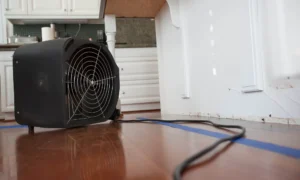Water is incredibly powerful and can cause a lot of damage to homes. Even a small leak can lead to big problems if not fixed. This can make your home unsafe and cause structural issues.
Homeowners often wonder when water damage becomes a big problem. Knowing the signs of water damage and acting fast can save you from expensive repairs.
Key Takeaways
- Small leaks can lead to significant structural damage if not addressed.
- Water damage can result in costly repairs if neglected.
- Identifying signs of water damage early is critical.
- Prompt action can prevent safety hazards.
- Understanding water’s erosive force is key to protecting your home.
How much water does it take to cause severe damage to a home?
The amount of water needed to damage a home varies. It depends on the water source, how long it’s exposed, and what materials it touches.
Water damage is divided into three types. Knowing these categories helps us understand the risks and what to do.
Category1, Category2, and Category3 Water Damage
Category1 damage comes from clean water, like broken pipes or rain. It’s the least risky.
Category2 damage, or gray water, has more contamination. It comes from appliances like dishwashers. It’s riskier than Category1.
Category3 damage, or black water, is the most contaminated. It’s from sewage, flooding, or other harmful sources. It’s the most dangerous.
How long water sits and what it touches also matters. Quick action is key to lessen damage risks.
- Category1 damage needs quick action to stop it from getting worse.
- Category2 damage requires careful handling to avoid health issues.
- Category3 damage needs a pro because of the big health risks.
Homeowners should know these categories and risks. This helps them take the right steps to fix water damage and prevent flooding.
Identifying and addressing water damage
Spotting water damage early is key to fixing it. Homeowners need to watch for signs that water damage is happening or about to happen.
Water damage can harm your home’s structure if not fixed fast. Look out for spiderwebbed cracks, paint bubbles, and flaking paint. Also, check for peeling wallpaper, water stains, and musty smells.
Common Signs of Water Damage
- Spiderwebbed and small hairline cracks on walls and ceilings
- Paint bubbles and flaking paint
- Peeling wallpaper
- Water stains and discoloration
- Musty odors
- Warped or sagging ceilings and walls
To stop water damage, keep up with maintenance and checks. Regularly inspect hoses, pipes, and faucets for leaks. This helps protect your home and saves on repair costs.
Fixing water damage quickly is vital. If you think your home has water damage, get professional help right away. Quick action can stop more damage and get your home back to normal.
Conclusion
Knowing how much water can damage a home is key to preventing problems. Home flooding risks can be lessened by understanding water damage’s effects. Taking action fast when needed is also important.
Fixing water damage means removing water, drying, cleaning, and making the home like new. The cost of fixing water damage can be high. So, acting quickly is vital to save money and protect your home.
Water damage can be serious, even from a small amount of water. Homeowners should take steps to stop water damage. They should also be ready to act fast in emergencies to keep repair costs down.
Recover with Assurance — Northwest Restoration of Washington
Whether it’s water, fire, mold, or storm damage, Northwest Restoration delivers fast, professional cleanup and restoration services you can trust. Available 24/7—contact us today!








